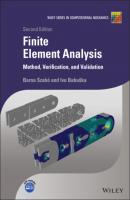Finite Element Analysis. Barna Szabó
Чтение книги онлайн.

Читать онлайн книгу Finite Element Analysis - Barna Szabó страница 36
Название: Finite Element Analysis
Автор: Barna Szabó
Издательство: John Wiley & Sons Limited
Жанр: Физика
isbn: 9781119426462
isbn:
We will find it convenient to write the relative error in energy norm in the following form
where N is the number of degrees of freedom and C and β are positive constants, β is called the algebraic rate of convergence. In one dimension for the h‐version and
for the p‐version. Therefore for
we have
. However, for the important special case when the solution has the functional form of eq. (1.89) or, more generally, has a term like
and
is a nodal point then
for the p‐version: The rate of p‐convergence is twice that of h‐convergence [22, 84].
When the exact solution is an analytic function then and the asymptotic rate of convergence is exponential:
where C, γ and θ are positive constants, independent of N. In one dimension , in two dimensions
, in three dimensions
, see [10].
When the exact solution is a piecewise analytic function then eq. (1.93) still holds provided that the boundary points of analytic functions are nodal points, or more generally, lie on the boundaries of finite elements.
The relationship between the error measured in energy norm and the error in potential energy is established by the following theorem.
Theorem 1.5
(1.94)
Proof: Writing and noting that
, from the definition of
we have:
Remark 1.10 Consider the problem given by eq. (1.5) and assume that κ and c are constants. In this case the smoothness of u depends only on the smoothness of f: If then
for any
. Similarly, if
then
for any
. This is known as the shift theorem. More generally, the smoothness of u depends on the smoothness of κ, c and F. For a precise statement and proof of the shift theorem we refer to [21].
Remark 1.11 An introductory discussion on how a priori estimates are obtained under the assumption that the second derivative of the exact solution is bounded can be found in Appendix B.
1.5.3 A posteriori estimation of error
The goal of finite element computations is to estimate certain quantities СКАЧАТЬ